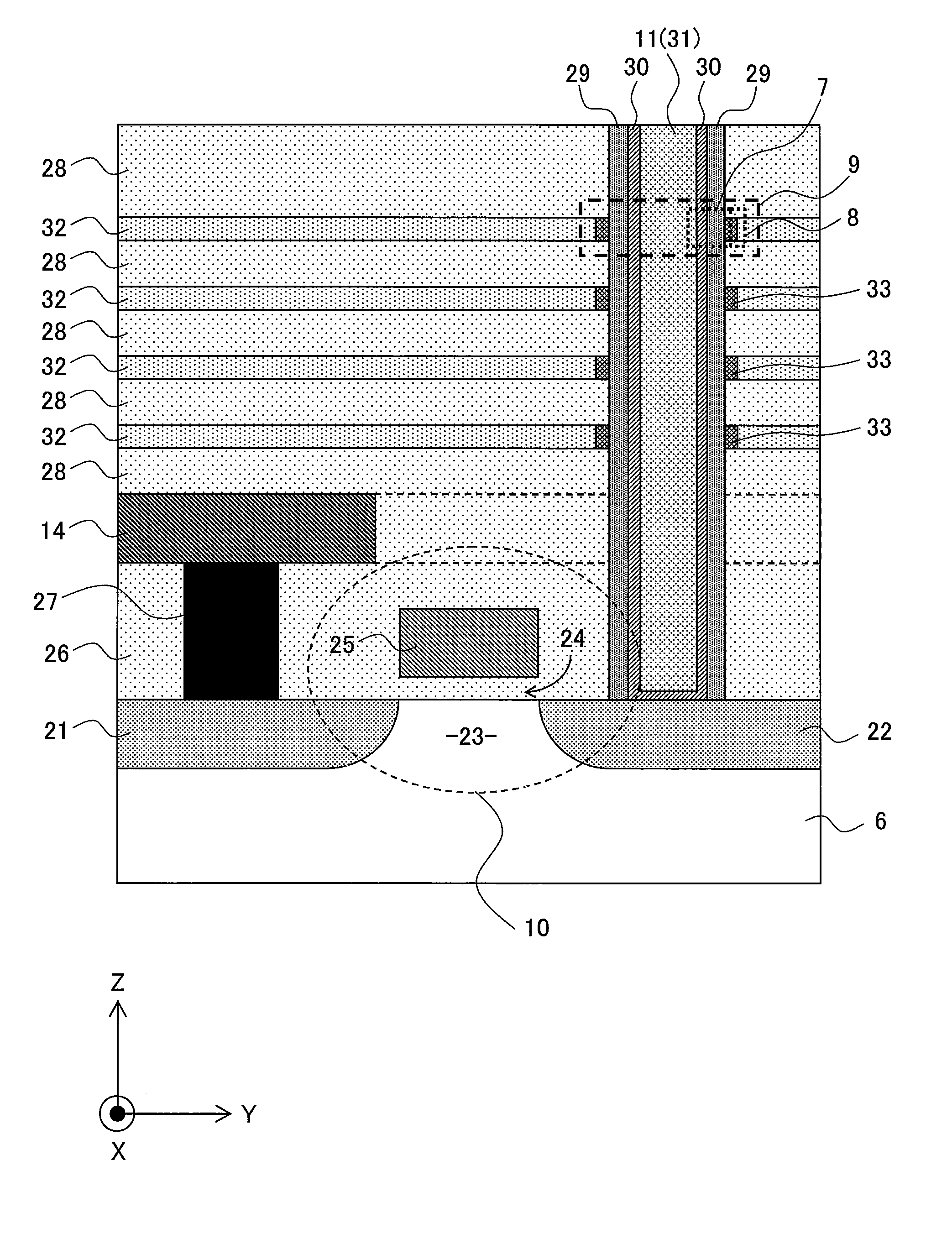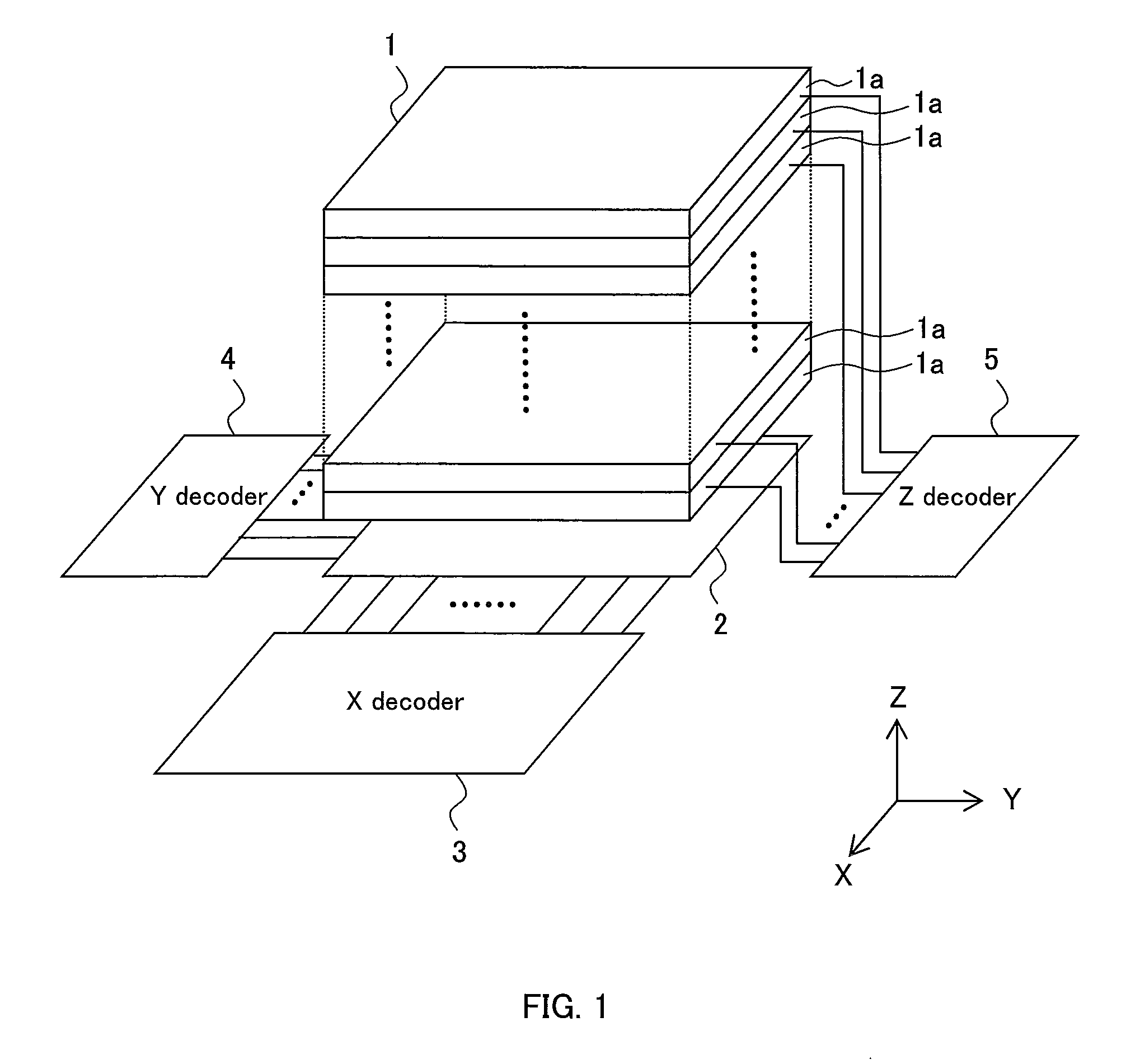Nonvolatile semiconductor memory device and manufacturing method for same
a semiconductor memory and non-volatile technology, applied in semiconductor devices, digital storage, instruments, etc., can solve the problems of difficult, or impossible, to detect the readout current, and achieve the effect of low cost, large capacity and low cos
- Summary
- Abstract
- Description
- Claims
- Application Information
AI Technical Summary
Benefits of technology
Problems solved by technology
Method used
Image
Examples
first embodiment
[0070]As schematically shown in FIG. 1, the device of the present invention is formed of a three-dimensional memory cell array 1, a two-dimensional array 2 of selection transistors, an X decoder 3, a Y decoder 4 and a Z decoder 5. The two-dimensional array 2, the X decoder 3 (corresponding to the first decoder), the Y decoder 4 (corresponding to the second decoder) and the Z decoder 5 (corresponding to the third decoder) are formed on the same substrate 6, and the three-dimensional memory cell array 1 is located above the two-dimensional array 2. Here, in the following description, the first direction and the second direction, which are parallel to the surface of the substrate 6 and perpendicular to each other, are the X direction and the Y direction, respectively, while the third direction, which is perpendicular to the surface of the substrate 6, is the Z direction.
[0071]In the present embodiment, the three-dimensional memory cell array 1 is formed of a number of memory cells 9 wi...
second embodiment
[0115]Next, the device according to the second embodiment of the present invention is described. According to the first embodiment shown in the above, selection transistors are formed of standard planar MOS transistors. In the case where selection transistors 10 are formed of planar MOS transistors in a two-dimensional array 2 having the wiring structure shown in FIG. 3, as shown in FIGS. 5 and 12, the electrodes for the drains 21, the sources 22 and the gates 25 are provided in a plane, and it is necessary to separate the contact holes 27 for connecting the drains 21 to the bit lines 14 and the through holes 34 for forming the middle selection lines 11 that are connected to the sources 22 from each other in the plane, and thus, a problem arises, such that the area occupied by each selection transistor 10, that is to say, the area occupied by each memory cell in the XY plane, is large in the three-dimensional memory cell array. When publicly known vertical MOS transistors are used a...
third embodiment
[0124]Next, the device according to the third embodiment of the present invention is described. Though 1D1R type memory cells are used as memory cells with two terminals in the above described first and second embodiments, the device of the present invention having the structure shown in FIG. 1 is possible even in the case where 1R type memory cells are used. This should be clear from the fact that the present invention does not relate to whether memory cells are of a 1R type or a 1D1R type, because the present invention is first characterized in that the three-dimensional memory cell array 1 and the two-dimensional array 2 of selection transistors 10 are combined via middle selection lines 11, so that the selection lines of the three-dimensional memory cell array 1 are formed only of the common plates 12 in an XY plane, and therefore, it is not necessary to use a photolithographic step using an expensive, state of the art stepper in order to form a two-dimensional memory cell array...
PUM
 Login to View More
Login to View More Abstract
Description
Claims
Application Information
 Login to View More
Login to View More - R&D
- Intellectual Property
- Life Sciences
- Materials
- Tech Scout
- Unparalleled Data Quality
- Higher Quality Content
- 60% Fewer Hallucinations
Browse by: Latest US Patents, China's latest patents, Technical Efficacy Thesaurus, Application Domain, Technology Topic, Popular Technical Reports.
© 2025 PatSnap. All rights reserved.Legal|Privacy policy|Modern Slavery Act Transparency Statement|Sitemap|About US| Contact US: help@patsnap.com



